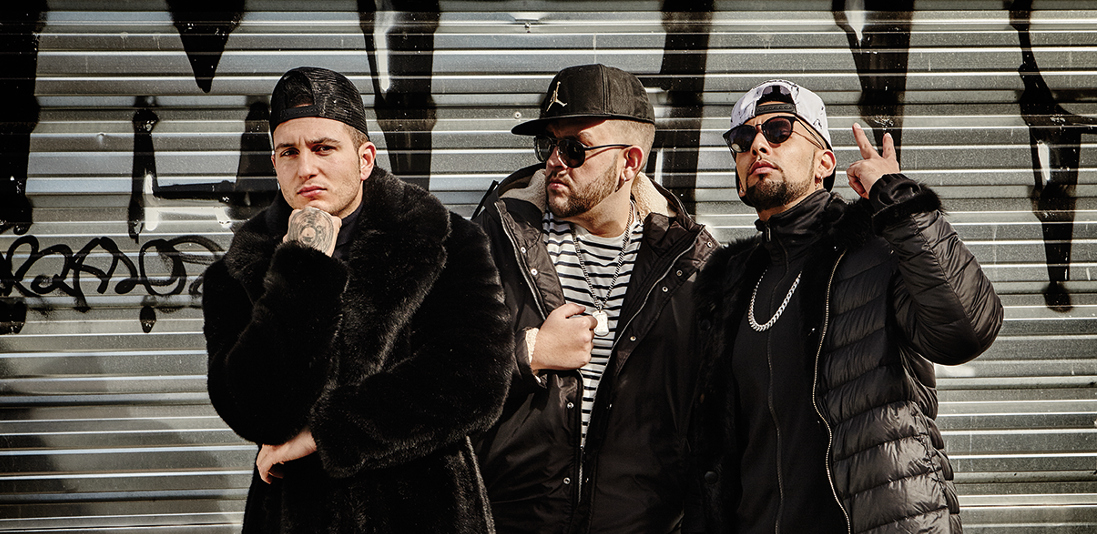Boricuas and Colombians beware: In the working-class neighborhood of Pan Bendito in Madrid, an urbano musical revolution is brewing.
Moncho Chavea, Original Elías, and Omar Montes are the self-made crew known as Los Chaveas. They write, produce, and perform songs and are influenced as much by reggaeton and salsa as by flamenco and Spanish-language rap. It’s Tego Calderón, Héctor Lavoe, Remedios Amaya, and Camarón all rolled into catchy club music that sounds entirely fresh. It’s a new approach for reggaeton and trap that no one in Latin America or the U.S. has taken before, and one which can catapult urbano to the next level.
Take for example “De la Tumba Salió,” in which Valencia-based artist Aloy raps, “Esto es España, no es Puerto Rico ni el Bronx/Aquí se escuchan por las calles canciones de Camarón.” The track, which samples Lavoe’s “El Día de Mi Suerte,” features Moncho Chavea, who appears in the music video holding his young son in his lap. Omar Montes and Moncho’s remix of “Krippy Kush” is flamenco, but also has salsa rhythms the original (which was made by Puerto Ricans) never had.
A few years ago, neighborhood friends Moncho, Elías, and Omar got started with a group they called Chavea Sound (from Los chavales del sonido, or the kids with flow). Eventually, the group split and Moncho took the name Chavea as an alter-ego for himself and for the sound he has developed as a producer for an ever-expanding list of collaborators, including Elías and Omar. In fact, Moncho (who resembles a young James Gandolfini) says he wants to be the “Quincy Jones” of this movement, and he is well on his way, based on YouTube views alone.
Yet unlike the telegenic Rosalía, C.Tangana, or Yung Beef, rising stars in the urbano scene in Spain and increasingly, abroad, you will barely find any coverage of the Pan Bendito crew in the Spanish media. They’re not polished in their homemade music videos, nor do they hang out with influencers on Instagram. Moncho will openly tell you that Moncho Chavea the artist is a fictionalized character he created, not who he is. “I go home to my wife’s lentejas. And they’re delicious,” he says.
Moncho, Elías, and Omar are Romani people, and in 2018, the gypsy community is still very marginalized in Spanish media and society. They are not taken seriously (The great flamenco singer Camarón only became an icon after his death, more than 25 years ago).
It’s a tale as old as hip-hop and reggaeton: people in marginalized communities are looked down upon until the authentic culture they have created cannot be ignored anymore and gets co-opted, domesticated, and mass-produced. Many times, those same pioneers are erased from the narrative.

Chavea and company have no album to their name, and barely any presence on streaming platforms. And yet earlier this month, Moncho, Elías, and Omar performed outside of Spain for the first time at the LAMC in New York City. What they have is a tremendous work ethic, a productive musical output, and a rabid fan base that continues to grow organically on YouTube. They have the blessing from flamenco royalty such as Remedios Amaya (she personally endorsed Moncho’s cover of her song “Tus labios pa’ mi,” and Omar collaborated with Camarón’s daughters on a trap cover of their father’s classic “Yo Soy Gitano”). Plus they have the Internet to bypass all the gatekeepers and reach more audiences, especially in Latin America.
Get to know Moncho Chavea, Original Elías, and Omar Montes in this feature video shot in their barrio of Pan Bendito.
A version of this story originally appeared in Spanish on Radio Gladys Palmera.







